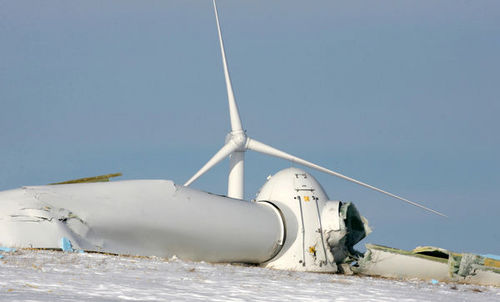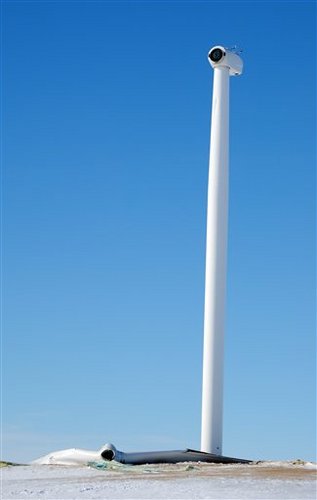
"It's a death sentence.
This has everything to do with eliminating wind power. That's why the proposal is so high.
It's a hit job."
- Michael Vickerman, who was a registered lobbyist for RENEW Wisconsin whose clients include Alliant Energy, ATC, We Energies, MG&E, North American Hydro, WPPI, and many wind developers with projects pending in our state. [SOURCE]
REFORM BILL POSES THREAT TO WIND FARMS IN OUR STATE
SOURCE: Wisconsin State Journal
January 15, 2011
By CLAY BARBOUR
Buried in a regulatory reform bill proposed by Gov. Scott Walker earlier this week lies a provision that wind energy insiders say could shut down 12 wind farm projects, cost investors billions and essentially kill the industry in the state.
In the bill announced Tuesday, Walker seeks to quadruple the distance between wind turbines and neighboring property.
The governor said the provision was written to protect homeowners, many of whom have complained about the encroachment of wind turbines in the rural parts of the state. Opponents of wind farms have complained of diminished property values, occasional noise pollution, moving shadows cast by the giant machines and loss of sleep from vibrations.
But critics this week called the provision a job killer and said it would earn Wisconsin a reputation for being hostile to alternative energy sources, such as wind.
"It would in essence shut down wind energy in the state," said Denise Bode, CEO of the American Wind Energy Association. "It is one of the most onerous regulations we have seen."
Bode said that, if passed, the measure would shut down 12 wind farm projects worth about $1.8 billion. Those projects, which are in various stages of planning, could produce about 950 full-time jobs for one year, she said.
"This is a shock to those of us in the wind industry," Bode said. "This will cause projects to go to other states."
Walker spokesman Cullen Werwie would not comment on specific criticisms of the bill, instead reiterating what has become the new Republican governor's mantra. "Governor Walker is focused on ensuring Wisconsin has a business climate that allows the private sector to create 250,000 jobs across all economic sectors," he said.
The proposal was met with applause from wind farm critics, like Elizabeth Ebertz. Ebertz, 67, lives in a little valley about a half-mile from a dozen 400-foot-tall wind turbines. The structures are part of the Blue Sky Green Field Wind Energy Center in northeastern Fond du Lac County, one of the state's largest wind farms, capable of producing energy for about 36,000 homes.
But according to Ebert, the turbines also produce enough noise to chase her from the garden - and, on most nights, disturb her sleep.
"I think it's a terrific idea, and long overdue," she said. "I have a lot of them now and I'd like to get rid of them."
‘Death sentence'
Bode said the wind industry employs about 3,000 people in Wisconsin. The state spends about $1.5 billion on imported energy every year and ranks 16th in the country in available wind.
According to the AWEA, Wisconsin has the capacity to produce up to 449 megawatts of energy from its existing wind farms - enough to power about 110,000 homes. Yet it trails other Midwestern states in wind energy production. Minnesota wind farms produce 1,797 megawatts, Illinois produces 1,848 and Iowa generates 3,670.
Industry insiders hoped new rules approved by former Democratic Gov. Jim Doyle would end years of localized fights - often spurred by well-funded anti-wind organizations - that killed at least 10 proposed wind farms in the past eight years and scared off several others.
Supporters hoped the new rules would help the state reach its goal of generating 10 percent of its energy from renewable sources by 2015. Renewable sources account for 5 percent of the state's energy now.
But Walker's proposal has many wondering what the future holds for the industry. Currently the state requires turbines have a setback from the nearest property line of 1.1 times the height of the turbine, or roughly 450 feet. The turbines are also required to have a setback of 1,250 feet from a home.
Walker's provision would push the setback from the property line to 1,800 feet (almost six football fields), a distance that industry experts say is unheard of in other states.
"It's a death sentence," said Michael Vickerman, executive director of RENEW Wisconsin, a Madison nonprofit that promotes clean energy. "This has everything to do with eliminating wind power. That's why the proposal is so high. It's a hit job."
Taking their business elsewhere
Vickerman said the new rules, if approved, would essentially end the industry's growth here. His sentiment is shared by many in the wind industry.
"This regulation goes far beyond what any other state has done," said Tim Polz, vice president of Midwest Wind Energy, a company currently planning a large wind farm in Calumet County. "This will kill our project."
The Chicago-based Midwest has developed seven wind farms in total and has 12 more in the planning stages. The company already built two wind farms in Wisconsin: the 36-turbine Butler Ridge Wind Energy Project in Dodge County and the 41-turbine Cedar Ridge Wind Farm in Fond du Lac County.
Polz said Midwest has already spent three years and about $1 million on the Calumet County project, which would employ between 150 and 200 construction workers for up to 18 months if it moved forward.
"This sends the message to us that Wisconsin does not want our business," he said.
Dean Baumgardner, executive vice president for the St. Louis-based Wind Capital Group, said Walker's proposal was disappointing, especially considering the governor's vow to create jobs.
Wind Capital, which has an office in Madison, has developed six farms and has 20 more in the planning stages - including a 40- to 60-turbine farm in Grant County. Baumgardner said Walker's proposal will likely kill the Grant County farm.
"But we will keep building wind farms," he said. "We will just do it elsewhere."
SECOND FEATURE:
 NOTE FROM THE BPWI RESEARCH NERD:
NOTE FROM THE BPWI RESEARCH NERD:
The setbacks proposed in the Walker bill will not be the strictest in the nation as stated in the article below. The claim seems to be based on statements from Denise Bode, head of the Amercian Wind Energy Association which is the largest wind lobbying organization in the nation.
EXTRA CREDIT QUESTION: Who is Denise Bode? Scroll down past the RED HANDS to read more about the AWEA and Denise Bode.
PROPOSED WIND RESTRICTIONS WOULD BE STRICTEST IN NATION
SOURCE Journal Sentinel, www.jsonline.com
January 14, 2011
By Thomas Content
The head of a wind industry trade group and a lobbyist for the Wisconsin Realtors Association squared off over Gov. Scott Walker’s wind farm siting proposals.
Denise Bode, chief executive of the American Wind Energy Association weighed in Friday on Wisconsin’s proposed wind-siting rule, calling it “the biggest barrier” to wind development in the country.
“This will be the biggest regulatory barrier in terms of setbacks in the country,” said Denise Bode, chief executive of the AWEA, based in Washington, D.C., in an interview Friday afternoon. “You’re adding a new regulator barrier and putting a ‘closed for business’ sign on Wisconsin for wind development.”
A restrictive environment for wind development will create a chilling effect for companies that manufacture parts for wind turbines to want to open plants in the state, following the lead of firms like TowerTech in Manitowoc and Ingeteam, which is building a factory in the Menomonee River Valley.
Many states have no setback requirements, deferring to local units of government. Of those that do, none has a setback as far as Wisconsin’s proposal, Bode said.
But Tom Larson, chief lobbyist for the Wisconsin Realtors Association, said the proposal is a strong defense for property rights.
“We think that with this bill Wisconsin would be the only state in the country to have an adequate setback for property owners,” said Larson.
He called the rule adopted by the Public Service Commission “the poster child for Scott Walker’s regulatory reform on how administrative rules are made,” noting that the rule was enacted by an agency and not elected government officials.
Developing wind farms in Wisconsin has generated more controversy than in some other states in part because its areas most suitable for wind turbines are more densely populated than rural expanses of Iowa, Minnesota and the Dakotas that host wind projects.
Opposition to wind farms led some counties to enact wind power moratoriums and other restrictive rules. The patchwork of local rules stalled projects, prompting the state Legislature to pass legislation to set a statewide standard.
Bode said the industry wasn’t pleased with – but could live with – the standard that was adopted by the Public Service Commission last year, Bode said.
Dan Ebert, who chairs the state’s wind siting advisory council, said the end result wasn’t perfect, but it did a better job at balancing the competing interests with this issue.
“We shouldn’t have the Realtors Association dictating energy policy in this state,” he said.
The proposed rule is more aggressive than the PSC rule because it would cover large utility-scale wind farm as well as smaller wind farms, said Ebert, a senior vice president with WPPI Energy in Sun Prairie.

Better Plan encourages you to contact Governor Walker's office to thank him for including these more protective setbacks in this bill and to also contact your senator and representative to encourage them to support it.
CONTACT Governor Scott Walker govgeneral@wisconsin.gov
115 East Capitol
Madison WI 53702
(608) 266-1212
CONTACT Legislators
Who Are My Legislators? To find out, CLICK HERE
Senate | Members | E-Mail Directory
Assembly | Members | E-Mail Directory
MORE ON WIND LOBBYISTS:
WANT BIG WIND? CHANGE THE LAW! ALL IT TAKES IS FIVE MILLION DOLLARS WORTH OF LOBBYING MONEY
Industry blitzes hill on Schumer bill, renewable mandate
SOURCE: The New York Times, www.nytimes.com
By ANNE C. MULKERN of Greenwire,
March 9, 2010
"The wind industry over the last year has made a major lobbying push. In 2009, the industry tripled spending on influence efforts from a year earlier. The American Wind Energy Association paid $5 million for lobbying in 2009, compared with $1.7 million the previous year, the highest amount ever for the association and a sixth of the $30.1 million spent by all renewable companies combined. It came in the same year that the wind industry saw its prospects lifted by legislation."
CLICK HERE TO READ ENTIRE ARTICLE
 DOE E-Mails To Wind Energy Lobbyists Cast Cloud Over Green Jobs Proposals
DOE E-Mails To Wind Energy Lobbyists Cast Cloud Over Green Jobs Proposals
By SEAN HIGGINS,
SOURCE: INVESTOR'S BUSINESS DAILY
03/10/2010
The Energy Department worked closely with the wind industry lobby to discredit a Spanish report that criticized wind power as a job killer, internal DOE e-mails reveal.
The e-mails obtained from a Freedom of Information Act request show how, starting last April, lobbyists at the American Wind Energy Association became alarmed that lawmakers were citing a study by Spain's King Juan Carlos University. The study found that Spain's massive investments in wind power cost 2.2 jobs for every "green" job created.
The study came out in early 2009 just as the wind lobby was building up its presence in Washington, hoping it could score big in an energy bill then being debated in Congress. Industry lobbyists feared the Spanish study would halt momentum for pro-wind legislation.
Study Fanned Wind's Fears
The e-mails show the wind lobbyists shared their concerns with DOE employees, who agreed the study needed to be refuted. In August, DOE produced a white paper specifically attacking the study.
For example, e-mails show the lobbyists requesting to know when the report would come out and DOE employees hustling to get it published because it was late.
"Is it okay if we send out our response (paper) to colleagues at AWEA and CAP? We promised it to them many weeks ago. It will soon be irrelevant," said energy analyst Suzanne Tegen, co-author of the DOE paper, in a July 29 e-mail to colleagues. CAP refers to the liberal Center for American Progress, which has pushed for renewable energy subsidies and has close ties to the Democratic Party.
CAP Senior Fellow Dan Weiss told IBD the center wasn't involved in drafting or editing the report, though it did promote it on its Web site.
The conservative Competitive Enterprise Institute obtained the e-mails via a Freedom of Information Act request and shared them with IBD. Many of the messages were redacted.
The e-mails are mainly between employees at DOE's National Renewable Energy Laboratory.
Conspiracy Or Cooperation?
Chris Horner, a senior fellow with CEI, is pushing further FOIA requests to get the remaining documents. He argues that the e-mail timeline indicates the Energy Department produced its study at the wind lobby's request.
"It doesn't seem to be the department's idea," Horner said. "That is clear."
AWEA CEO Denise Bode called charges it got DOE to produce the study "absolutely false." Yes, the association worked with the administration on the issue, she said, but argued it was just how business is done in Washington.
NOTE FROM THE BPWI RESEARCH NERD: This sort of green manipulation makes for strange bi-partisan bedfellows.
Look a little closer at AWEA CEO Denise Bode, a conservative Republican with strong ties to the petroleum industry, and appointee to George W. Bush's Energy Transition Advisory Team.
CLICK HERE FOR SOURCE
Denise Bode (born 1954, Tulsa, Oklahoma) is a nationally recognized energy policy expert and a former Corporate Commissioner of that state.
In January 2005 she began her second and last six-year term in office, having won reelection by the most votes ever garnered by a Republican candidate for an Oklahoma.
Appointed by Governor Frank Keating, Bode took office on August 20, 1997 and was elected on November 3, 1998 with over 60% of the vote, a record for a Republican running statewide for the first time. She was reelected to her second full term in November, 2004.
Before joining the commission, Bode served for seven years as president of the Independent Petroleum Association of America (IPAA) in Washington, D.C.
Bode was appointed to President George W. Bush’s Energy Transition Advisory Team[6] and has testified before Congress on numerous occasions, as well as lectured at the Heritage Foundation and the Federalist Society.
She represented the United States in Oslo, Norway, at the International Union Conservative Women’s Conference.
She was elected by state regulators from the eight states that make up the Southwest Power Pool (SPP) region to serve as President of SPP’s Regional State Committee. The committee is charged with directing electric transmission expansion in Oklahoma and the other states in the SPP region.
Now look at Bode's 'cleansed' bio from the AWEA site which makes no mention of her ties to big oil and her conservative, Republican roots. Why leave this out?
DENISE BODE TO BECOME CHIEF EXECUTIVE OFFICER
OF AMERICAN WIND ENERGY ASSOCIATION
SOURCE: AWEA
WASHINGTON, D.C. – The American Wind Energy Association (AWEA) today announced the appointment of Denise Bode as its new CEO, effective January 2, 2009.
Bode will succeed Randall S. Swisher, who is retiring after a 19-year stint with AWEA.
Bode, who is currently CEO of the American Clean Skies Foundation, is a nationally recognized energy policy expert and served for nine years on the Oklahoma Corporation Commission. Her experience in the energy field is extensive and includes seven years as President of the Independent Petroleum Association of America (IPAA) and nine years on the staff of then–U.S. Senator David Boren (D-OK) as his legal counsel, focusing on the areas of energy and taxation.
“Denise Bode is an extremely dynamic and well-respected leader on energy issues in Washington, D.C.,” said Swisher, “and brings a wealth of knowledge and experience to AWEA. We are very fortunate to have such a talented and able individual available to lead the Association at a time when renewable energy stands on the threshold of dramatically expanding its contribution to America’s energy supply.”
“We were very lucky to have Denise’s leadership to get ACSF established as a real player in the debate on energy and the environment,” said Aubrey K McClendon, Chairman and Founder of the American Clean Skies Foundation.
“I am thrilled by my new opportunity of working with the AWEA team to grow wind power in the U.S.,” Bode said. “I am particularly proud of the role I played as Oklahoma Corporation Commissioner to bring commercial wind power to Oklahoma.”






